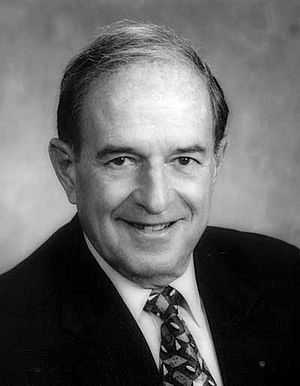David Atlas facts for kids
Quick facts for kids
David Atlas
|
|
|---|---|
 |
|
| Born | May 25, 1924 Brooklyn, New York, U.S.
|
| Died | November 10, 2015 (aged 91) Silver Spring, Maryland, U.S.
|
| Known for | Radar meteorology |
| Awards | Numerous, including Symons Memorial of the RMS in 1989 and Carl-Gustaf Rossby Research Medal in 1996 from the AMS |
| Scientific career | |
| Fields | Meteorology |
| Institutions | U.S. Air Force, University of Chicago, National Center for Atmospheric Research and NASA |
David Atlas (born May 25, 1924 – died November 10, 2015) was an American scientist. He was a very important person in the field of radar meteorology. This means he helped create and improve the radar technology we use to track weather. His work started during World War II and continued throughout his life. He worked for the U.S. Air Force, taught at the University of Chicago, and did research for NASA. David Atlas had 22 patents and wrote over 260 scientific papers. He also received many awards for his amazing contributions to science.
Contents
Early Life and Radar Beginnings
David Atlas was born on May 25, 1924, in Brooklyn, New York. His parents had moved to the U.S. from Poland and Russia. He went to school in Brooklyn. Later, he started college at the City College of New York.
During World War II, Atlas joined the US Army Air Corps. This is where he began his work with radar. He helped develop radar systems. He especially focused on how radar could detect rain and other weather.
After the war, Atlas stayed with the U.S. Air Force for 18 years. He worked at the Air Force Cambridge Research Laboratories in Bedford, Massachusetts. There, he led a team that researched weather radars. While working, he also earned his Master's and Doctorate degrees. He studied how the Doppler Effect could be used to measure wind. This was a big step for weather forecasting.
A Career in Meteorology
From 1966 to 1972, David Atlas was a professor. He taught meteorology at the University of Chicago. Meteorology is the study of Earth's atmosphere and weather.
Then, from 1972 to 1976, he became a director. He led the atmospheric technologies division at the National Center for Atmospheric Research (NCAR) in Boulder, Colorado. His team's work was very important. It helped create the NEXRAD system. This is the network of Doppler weather radars used across the United States today.
In 1977, Atlas started a new lab at NASA. It was called the Laboratory for Atmospheric Sciences. This lab was at the Goddard Space Flight Center in Greenbelt, Maryland. The center created many tools for weather satellites. These tools help scientists study the atmosphere, oceans, and icy parts of Earth.
Later Years and Awards
David Atlas officially retired in 1984. However, he stayed very active in science. He continued to work on radar meteorology. He was a member of many important groups. These included the American Geophysical Society and the Royal Meteorological Society (RMS). He was also a member of the National Academy of Engineering.
Atlas was a fellow of the American Meteorological Society (AMS). He even served as its president in 1975. He received many awards for his work. In 1988, he got the Symons Gold Medal from the RMS. In 1996, he received the Carl-Gustaf Rossby Research Medal from the AMS.
In 2004, he was given the Dennis J. Picard Medal. This award recognized his "outstanding leadership and significant individual technical contributions" to using radar for weather.
Passing Away
David Atlas passed away on November 10, 2015. He was 91 years old. He died in Silver Spring, Maryland, after complications from a stroke.
See also
- History of radar
- Roger Lhermitte

